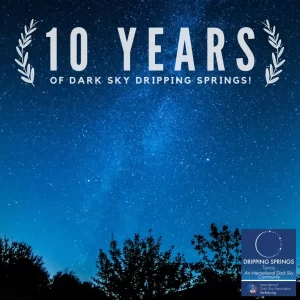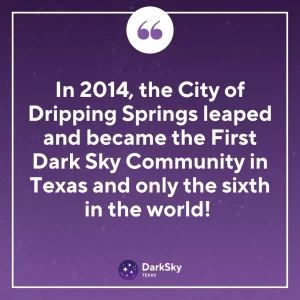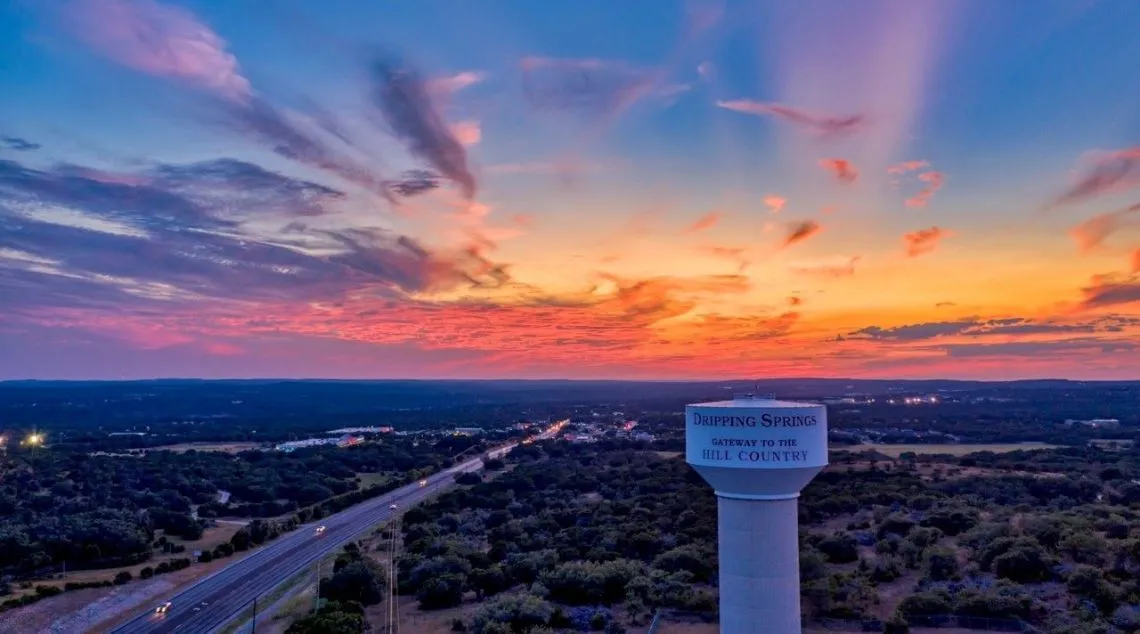Following years of advocacy and some patient redesign projects, DarkSky Texas members have helped create over 20 International Dark Sky Places across the state. And now, one of the first to earn one of these awards is celebrating its 10th anniversary! In just a decade, these efforts are already impacting the animals, plants, and people who live there, as well as the town’s local economic prospects.
Let’s quickly look at the First International Dark Sky Community in Texas, the City of Dripping Springs, and explore what it takes to become the next International Dark Sky Place in Texas.
What is an International Dark Sky Place?
The International Dark Sky Places (IDSP) program certifies communities, parks, and protected areas around the world that preserve and protect dark sites through responsible lighting policies and public education.
Dark Sky Places are committed to following the 5 principles of responsible outdoor lighting, which requires outdoor lights to be: Useful, Targeted, At the lowest level necessary, Controlled, and Yellow or warm-colored.
State and national parks were the first areas in Texas committed to protecting their night skies. These parks had a vested interest in keeping a slice of nature pristine. Big Bend National Park took the first step in 2012 with Copper Breaks State Park following in 2014.
However, getting local communities committed to becoming International Dark Sky Places can be more difficult as it requires more coordination and buy-in from members within the community.
City of Dripping Springs Commits to Dark Skies
In 2014, the City of Dripping Springs took the leap and became the First International Dark Sky Community in Texas and only the sixth in the world at that point!

Located near Austin, Dripping Springs, TX was no stranger to better lighting and protecting the night sky. The city was also one of the first Texas cities to pass an ordinance regulating outdoor lighting back in 2000. However, getting approved as an International Dark Sky Place would be no easy task.
Cindy Luongo Cassidy of DarkSky Texas initiated the application process to get Dripping Springs approved. However, for any community to take on this process, the city must take ownership to make it happen. Michelle Fischer, the Dripping Springs City Administrator, led the activities needed by city staff and heavily supported the entire process.
While Cindy wrote the new compliant outdoor lighting ordinance, gathered the data, and prepared the bulk of the nomination package, Joan Mihal, also of DarkSky Texas, wrote the history section. Michelle worked with City Council to secure their buy-in, assisted with gathering letters of support, and played an integral role in getting Dripping Springs approved. It was truly a team effort.
Once approved, the City of Dripping Springs generated significant attention. Additional DarkSky Texas members joined that team as they led an extremely successful Better Lights for Better Nights Conference, followed by three Texas Night Sky Festivals®, where multiple thousands from around the area and well beyond Texas were educated and inspired.
The efforts in Dripping Springs had set the stage for more communities in Texas to follow.
New Dark Sky Communities in Texas
A few years later, other communities in Texas, such as Horseshoe Bay and Fredericksburg, followed in their footsteps. As of this writing in 2024, Texas now has six communities in Texas that are designated Dark Sky Places:
- City of Dripping Springs, January 2014
- City of Horseshoe Bay, November 2015
- City of Fredericksburg, February 2020
- City of Blanco, April 2022
- City of Bee Cave, April 2023
- City of Jonestown, January 2024
See the full list of International Dark Sky Places in Texas here!
Benefits of Becoming an International Dark Sky Place in Texas
These communities have seen an uptick in tourism, especially around astronomical events. As dark skies become a rare treat worldwide, people will travel long distances to glance at their skies. But that’s just the cherry on top of:
- Community members who are happier and healthier
- Preserving nature and local ecosystems
- Protecting plants and wildlife species that require darkness
- Saving energy and money and improving visibility after dark
The Next International Dark Sky Places in Texas?

Over the past four years, four new communities in Texas have become approved International Dark Sky Places, and our team at DarkSky Texas looks forward to adding many more to that list.
The first step in becoming an International Dark Sky Community in Texas is attending our monthly 1st Wednesday Dark Sky Places Coaching. It’s at 5 PM on the first Wednesday of each month on Google Meet, and it’s open to anyone interested in learning more about becoming a Dark Sky Place in Texas.
From there, DarkSky Texas will help you through the application and approval process. Have questions? Contact DarkSky Texas today!
How Can Individuals Commit to Dark Skies?
The designation of an International Dark Sky Place starts with individuals who are committed to preserving the night sky. Here’s how individuals can help be a part of the solution to stop light pollution.
- Improve the lighting on your personal property and earn the BE A STAR award.
- Donate or volunteer to help DarkSky Texas educate on the importance of preserving the night sky in our state.
- Attend the monthly 1st Wednesday Dark Sky Places Coaching and learn how you can help encourage your local community to become more friendly to the night sky.
DarkSky Texas is committed to supporting any sincere effort to preserve the night sky with equally extensive help: our members and volunteers stand by to guide, support, and coach Texans who are ready to get started.
Image Credit: Dripping Springs Facebook Page


